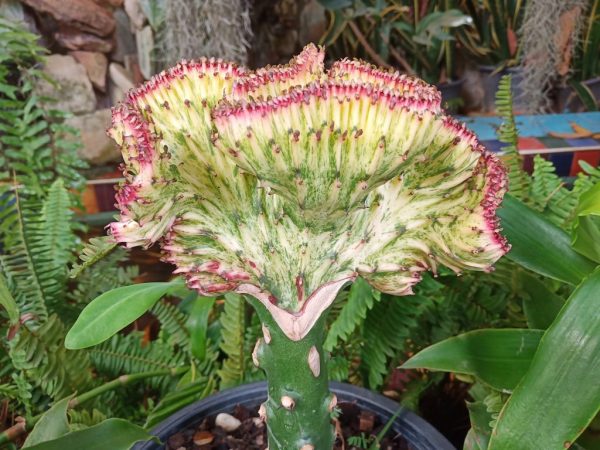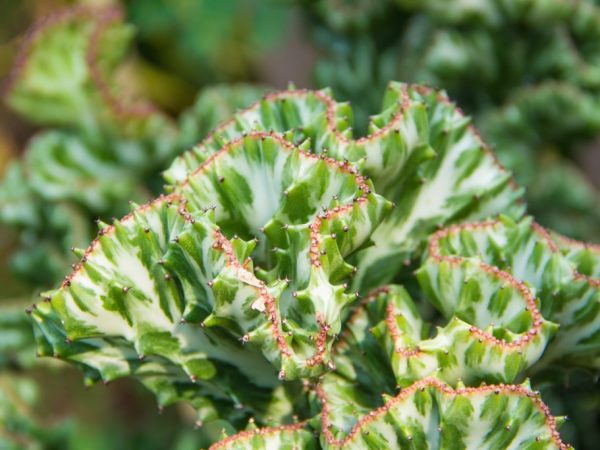Euphorbia Laktea Kristata - how to care at home
Euphorbia Laktea Christata is a tropical succulent native to the hottest countries of Asia. The name translated from Latin means "Milk combs", which successfully illustrates the original shape and color of the plant. The cultivation of this milkweed has a certain specificity, requires careful care, knowledge and skills.

Euphorbia Lactea Christata
Description
Euphorbia lactea cristata is a perennial euphorbia with an amazing shoot. He looks like an open fan or a bizarre sea inhabitant. There are two forms of this euphorbia: variegated and crested. The first cannot grow without a rootstock, and the second is able to exist on its own roots (but most often it is grafted onto another stem anyway).
The color palette of the plant is quite diverse. It includes greenish, milky, pinkish and metallic shades. Small thorns are located on the ribs of the scallop, small flowers appear on the wavy edges. In nature, milkweed grows large oblong leaves, but at home they quickly disappear.
Like other types of euphorbia, Laktea secretes poisonous juice when fractured. Contact with the skin or mucous membranes, the substance causes burns and irritation.
Purchase and adaptation
Euphorbia Cristata is a rather rare species that is not found in every store. Since growing it is not easy, it is important to get a healthy plant (so as not to create additional problems for yourself). There should be no dark spots, dry, damaged or softened areas on the stem and ridge.
- 3-4 weeks euphorbia adapts to a new place of residence. During this time, the lacta should not be disturbed and transplanted.
- She needs to create comfortable conditions (warm, good lighting, moderate watering) and, as a precaution, place it separately from other flowers.
- Top dressing is not applied in the first month after purchase - the plant has enough nutrients contained in the store substrate.
The necessary conditions
| Temperature | Priming | Lighting |
| The species is extremely thermophilic. It can withstand temperatures of 30 ° C, but the ideal summer rates for it are 24-26 ° C. In winter, the scale should not fall below 22-20 ° C. When growing Kristata at home, a device for heating the air is very useful. | It is necessary to take a loose, light, permeable soil with a slightly acidic reaction. The easiest way is to choose the appropriate substrate for your succulents. There should be a thick layer of drainage underneath, since waterlogging is destructive for Laktea. | This type requires good and uniform illumination. It will quickly fade and weaken in partial shade, but it will not stand direct sunlight either. It is not recommended to artificially illuminate Lakteya. |
Home care
Laktea Kristata is a rather whimsical plant. Caring for it must be careful and thoughtful, since it must satisfy the dual needs of the scion and rootstock.However, if you look after properly and carefully, it is quite possible to grow a beautiful and healthy euphorbia.
Watering
Water the plant every 10 days, making sure that the substrate dries up, but does not dry out completely (in winter, watering is carried out once a month). Overmoistening in this case is unacceptable (it is better not to top up than to pour).
Water needs soft, settled, room temperature. Lakteya does not like humid air, it cannot be sprayed.
Fertilizers
In the summer and spring, euphorbia is fed monthly. In the winter period of rest, feeding is stopped. A complex mineral composition for succulents is chosen as a fertilizer.
Transfer
Lactea is rarely transplanted: its root system should be compactly placed in a small pot. If the roots are allowed to grow, branching of the stem will begin, side shoots will appear, which will partially take away food from the main comb. However, once every 3-4 years, euphorbia can be transplanted by increasing the capacity by no more than 2 cm. When transplanting, it is important to observe precautions: wear rubber gloves and goggles.
Pruning
Over time, new shoots may appear on the rootstock and crest. To preserve the decorative appearance of the milkweed and good nutrition of the main scallop, you need to prune. The processes are broken off by hand (wearing rubber gloves and goggles) or cut off with a disinfected sharp knife. The cut sites are treated with an antiseptic.
Reproduction

Propagated by cuttings
It is difficult to propagate Laktea at home - only advanced growers can do it. The only available method is grafting. The scallop or appendix is cut off with a sharp knife (previously disinfected) and placed in warm water to rinse from the juice.
Within three to four days, the cutting is dried. The cut sites are treated with an antiseptic. After that, it is possible to plant the shoot in a moist rooting substrate, but it is better to immediately graft it from the trunk of another milkweed.
Diseases and pests
| Problem | Symptoms | Prophylaxis | Treatment measures |
| Mealybug | Small whitish insects and cotton-like bloom can be seen on the trunk or scallop. | Regularly inspect Lakteya, observe the temperature regime. | Clean the euphorbia with a soft brush and soapy water. Treat with insecticides (Aktara, Confidor, Fitoverm). |
| Spider mite | Dark dots and cobwebs. | Avoid humidity, observe moderate watering. | Spray with a special preparation - acaricide (Vermitic or Aktofit). |
| Root rot | Stopping growth, wilting, darkening of the stem and ridge, the appearance of softened areas. | Observe disinfection and proper care measures: comfortable temperature, low humidity, moderate watering. | Remove damaged parts of the flower; Treat with a fungicide (Trichodermin, Mikosan, Copper sulfate). Transplant Laktea into a new substrate. |

